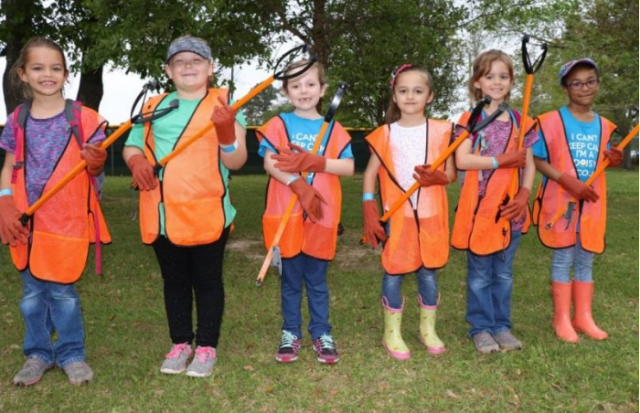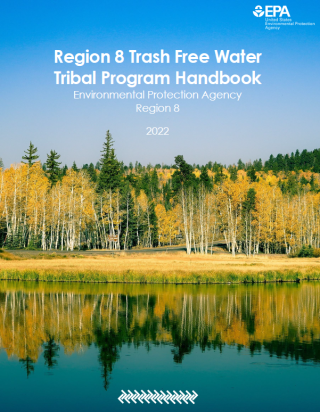Community Engagement Projects
On this page:
- The Trash Free Texas Adopt-A-Spot Tool
- Greater Houston and Galveston Bay Annual "River, Lakes, Bays 'N Bayous Trash Bash"
- Region 8 Trash Free Waters Tribal Program Handbook
The Trash Free Texas Adopt-A-Spot Tool
- Project Champion: The Meadows Center at Texas State University and local government leaders
- EPA Contribution: $ 25,000 in contractor support
- Project Period: 2016- ongoing
- Point of Contact: Cody Whittenburg, City of Fort Worth,[email protected]
- EPA Point of Contact: Huy Vu, U.S. EPA Region 6, [email protected]
Project Description
What began as Trash Free Trinity, an initiative in the Trinity River watershed in Texas, has now expanded to become a state-wide program called Trash Free Texas.
The Trinity River supplies water to over 6 million people in the state of Texas. Starting near the Dallas- Fort Worth metroplex and flowing for 708 river miles, the Trinity River eventually meets the Gulf of America just northeast of Houston and brings along with it an enormous amount of trash picked up along the way. Project champions include: The Meadows Center at Texas State University, City of Fort Worth, North Central Texas Council of Governments, Keep Texas Beautiful, Texas Department of Transportation/Don’t Mess With Texas, the Houston-Galveston Area Council and many others. With leadership from EPA Region 6 staff, the Trash Free Texas online mapping tool was formally launched in February 2017. After collaborating to refine the concept, the development of this groundbreaking tool was funded with support from the American Chemistry Council. Today, by accessing www.trashfreetexas.org, users can use point-and-click technology to adopt or foster a local litter hotspot plotted by state or local government officials. The goal of this Adopt-a-Spot tool is to foster a litter-free environment in the State of Texas by enabling community leaders to identify, promote, and track trash removal activities in their region, while maintaining a holistic watershed focus. Hear more about these efforts by watching the following video: https://h-gac.sharefile.com/share/view/sd0ef883ad204fa39.

Successes
Due to the project’s success, leaders across the state worked to systematically expand the program to every major watershed in Texas. The Core Team, noted above, was most recently augmented with representation from San Antonio, Waco and Austin in 2019 and 2020. Working together, partners have developed a five-year plan for expansion as well as a formal communications strategy. The initiative continues to expand across the state, with dozens of sites adopted and more than 50 communities engaged. In just a few clicks, users can now look up sites at a specific location or address, determine site adoption status, and immediately connect to a local community coordinator, such as a Keep Texas Beautiful affiliate, to begin the process of adopting or fostering a site as their own. Aside from improving site adoptions across Texas, the statewide network of partners gain valuable synergy by working together to achieve common missions in their specific communities. The initiative allows flexibility for each program coordinator to retain complete, independent control of their local site adoptions program requirements while maintaining alignment. In addition, smaller communities are able to gain access to geographic information (GIS) system technology that might have previously been unavailable.
In April, US EPA Headquarters hosted a webinar outlining the evolution and current use of the tool. Visit our webinar library to watch it.
Greater Houston and Galveston Bay Annual "River, Lakes, Bays 'N Bayous Trash Bash"
- Project Champion: The Conservation Fund, Houston Galveston Area Council, the Galveston Bay Estuary Program (GBEP)

Young volunteers at Lake Houston. Photo courtesy of the Galveston Bay Estuary Program. - EPA Contribution: In-kind support and partial sponsorship (GBEP)
- Project Period: 2018- ongoing
- EPA Point of Contact: Huy Vu, U.S. EPA Region 6, [email protected]
Project Description
The "River, Lakes, Bays 'N Bayous Trash Bash" brings together volunteers along Texas’ waterways to do their part in cleaning up the environment by participating in the largest, single-day waterway cleanup in the state. The mission of the Trash Bash is to promote environmental stewardship of our watersheds through public outreach while utilizing hands-on educational tools and by developing partnerships between environmental, governmental, and private organizations.
The Galveston Bay Estuary Program (GBEP), a National Estuary Program location, plays an active role in funding and putting on this event. In doing so, GBEP also supports many of their organizational goals including: 1) Establish citizen involvement as an integral part of the program; 2) Develop and implement a long-range adult education and outreach program; 3) Continue to develop effective volunteer opportunities for citizens; and 4) Improve trash management near the shoreline. The Trash Bash also works to address goals outlined in the “Charting the Course to 2015: Galveston Bay Strategic Action Plan.”

Successes
Since the annual event started in 1994, more than 113,000 citizens of all ages have come out to help clean up Galveston Bay. In 1994, there were 5 cleanup sites, 5,000 volunteers, and 150 tons of trash were collected. In 2019, over 4,300 volunteers were spread out across 16 sites, collecting a total of 57 tons of trash. Lori Traweek from the Texas Conservation Fund suggests this reduction in debris collected is a reflection of effective environmental education and stewardship efforts. From 1994-2018, volunteers collected a cumulative total of 2,274 tons of trash, 17 tons of recycling, and 11,065 discarded tires from over 1,605 miles of Texas shoreline.
Half of the 2019 volunteers were under the age of 18, a quarter of which were involved in Boy Scouts or Girl Scouts. The 2019 cleanup event also involved interactive games to help further engage participants in the issue. Many of the educational displays and activities were funded by previous Galveston Bay Estuary Program funds. One of the greatest highlighted impacts of the event is its impact on children from inner-city environments to help them understand how upstream behaviors can impact Galveston Bay. The Texas Conservation Fund and the Houston/Galveston Area Council received the 2019 1st Place Gulf Guardian Award for their efforts on the initiative! In 2018, the event was awarded the Texas Environmental Excellent Award. A recap video of the 2019 event can be found here . To volunteer and promote a healthy Galveston Bay watershed, visit The River, Lakes, Bays ‘N Bayous Trash Bash website.
Region 8 Trash Free Waters Tribal Program Handbook

- EPA Contribution: Technical Assistance
- Project Period: 2020-2021
-
EPA Point of Contact: Karen Simpson, [email protected]
Project Description
The Trash Free Waters team in EPA's Region 8 office (which covers Colorado, Montana, North Dakota, South Dakota, Utah and Wyoming) has developed a handbook to assist Tribal governments, Indigenous communities, and other relevant stakeholders to develop and implement projects that reduce trash in waterways on Tribal lands. While there is no one-size-fits-all solution to trash pollution, this handbook provides basic information on project design, implementation, and funding to serve as a starting point for those interested in taking action to reduce escaped trash in their community. This resource was developed specifically for Region 8 Tribes, but much of the information related to project development and funding opportunities may be helpful to tribal and other communities outside of Region 8 as well.
- View the Region 8 TFW Tribal Program Handbook (pdf) (January 2022)
